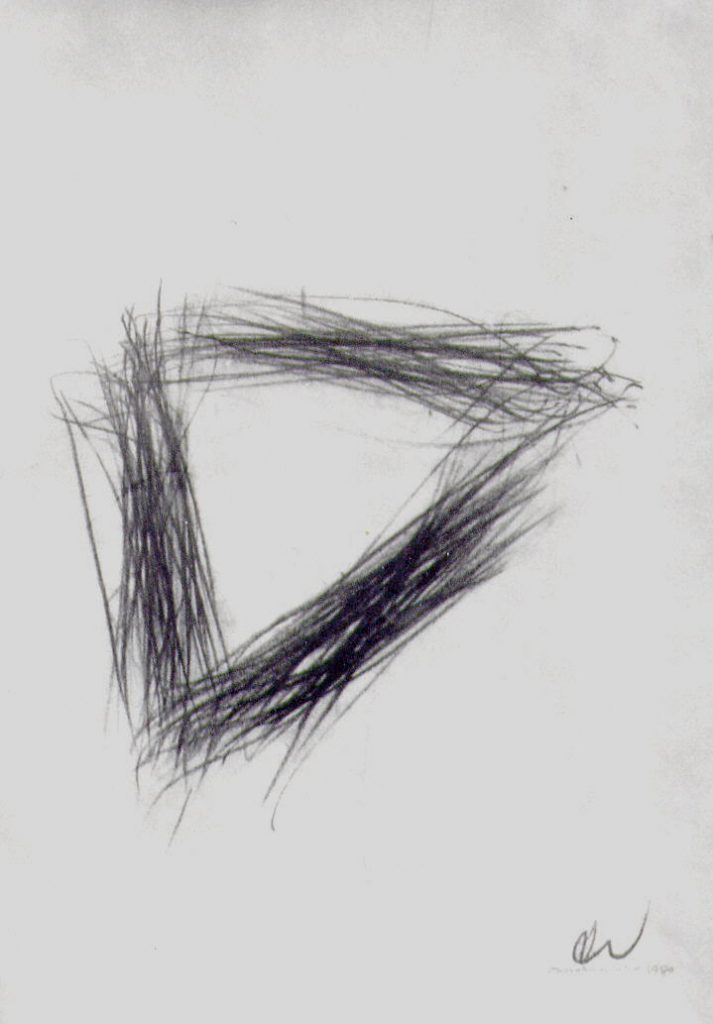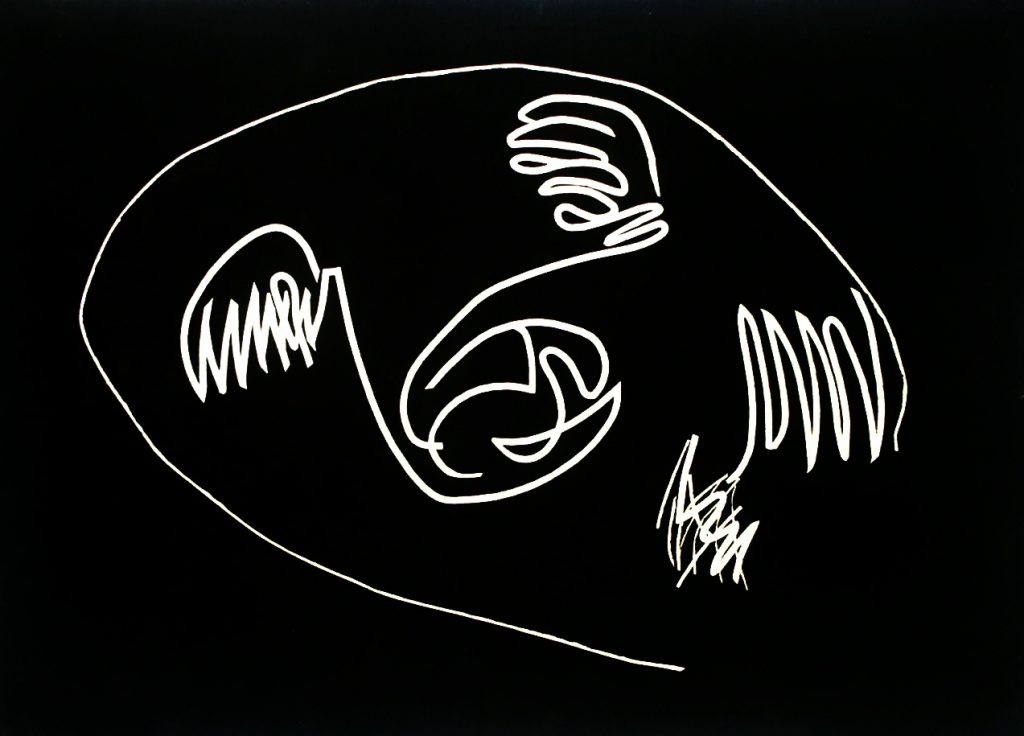L’Io dell’Immagine
RACCONTI D’ESTATE (4)
da “L’Io dell’Immagine” Ambrosio Paolo
editore Albatros Il Filo S.r.L. Roma 2019 ISBN 978-88-567-9768-8
Disegno 31/ Sono nata attraverso un pensiero libero nel momento in cui le forze lineari si animavano in coesione col centro che assorbiva e emanava una grande energia plasmandola in un intensità vibrante su se stessa. Paolo Ambrosio me fecit, 1981, Disegno 31, matita su carta cm. 50×35.
I.:La percezione (7) di noi immagini suscita un evento estetico-cognitivo con associazione visuale-emozionale. Le emozioni(8) con propri dispositivi di attenzione e memoria operativa hanno proprietà cognitive e generative. Non mi concedo, nella veste d’immagine, semplicemente per far felice l’altro, non illudo, cerco di edificare un nuovo paradigma mentale con linguaggio diverso dalle parole e attraverso dispositivi d’interesse selettivi. Coloro che mi desiderano entrano in me mettendo in discussione i loro pregiudizi e scoprendo dimensioni inattese fino al punto che, privati della sicurezza delle loro abitudini visive, possono essere colti dall’angoscia. I contenuti emozionali sorgono tra guardare vedere e Tiziana Pastore al tal proposito nel suo “Come le emozioni influenzano il cervello” chiarisce all’oggi Il teatro delle emozioni con osservazioni interessanti sulla dimensione del sentimento, della coscienza, e dell’autocoscienza (9)
I.: The perception (7) of us images triggers an aesthetic-cognitive event with visual-emotional association. Emotions (8) with their own attention devices and working memory have cognitive and generative properties. I do not allow myself, in the guise of an image, simply to make the other happy, I do not deceive myself, I try to build a new mental paradigm with language other than words and through selective interest devices. Those who desire me enter into me questioning their prejudices and discovering unexpected dimensions to the point that, deprived of the security of their visual habits, they can be seized by anguish. Emotional contents arise between looking and seeing and Tiziana Pastore in this regard in her “How emotions affect the brain” now clarifies The Theater of Emotions with interesting observations on the dimension of feeling, conscience, and self-awareness (9)
Il momento gestuale è analogo alla condizione di trance, è un agire lasciando scorrere il pensiero senza un intento preciso e senza alcun luogo di approdo. Il pensiero nella sua fluidità compone una congerie d’immagini sovrapposte che si offrono con le loro caratteristiche opportunità. Attraverso il ragionamento non deduttivo ove non tutte le premesse sono certe ma alcune probabili, ma abductivo, cioè senza regole di frequenza, probabilità, si apre una finestra sull’idea di struttura per sapere di che cosa e come è fatta la cosa che si cerca di formare. La mente, come nel gioco con il lego, introduce un oggetto che insieme con altri frammenti configura un qualcosa d’instabile che richiede altri interventi selettivi Quando l’equilibrio si rompe, si ricomincia spontaneamente l’operazione come se l’importante non fosse ottenere qualcosa ma il movimento stesso che rinasce in modo infinito, qualcosa che resta nascosto come il significato. La traccia della matita, preordinata dal gesto, non è mera grafite ma, nel momento in cui si manifesta in segni, è uno stato dello spirito con macchie, e chiazze. È l’informe che emerge dalla materia. I tratti non sono in antitesi con la superficie che li accoglie ma sono tracce in movimento ritmico connesse in una relazione organica. La perizia, coadiuvata dai processi propriamente cognitivi della coscienza, determina una condizione fluida, un respiro, ove tutto si svolge in modo necessario. L’immaginazione dell’osservatore ricostituisce i legami attraverso le tracce della matita lasciate sulla superficie e viene ricondotta a rivivere il gesto creativo originario.
Nel Disegno 31, fig. 21, (p.58) ad esempio, il piacere visivo che scaturisce è molto difficile da spiegare in quanto appartiene alla lettura personale che il singolo puo’ produrre in base alle sue specifiche competenze estetiche
The gestural moment is analogous to the condition of trance, it is an action letting the thought flow without a precise intent and without any place of landing. Thought in its fluidity composes a jumble of superimposed images that offer themselves with their characteristic opportunities. Through non-deductive reasoning where not all the premises are certain but some probable, but abductive, that is, without rules of frequency, probability, a window opens on the idea of structure to know what and how the thing you are looking for is made to form. The mind, as in a game with lego, introduces an object that together with other fragments configures something unstable that requires other selective interventions.When the balance is broken, the operation is spontaneously restarted as if the important thing was not to obtain something but the movement itself that is reborn in an infinite way, something that remains hidden as the meaning. The trace of the pencil, preordained by the gesture, is not mere graphite but, when it manifests itself in signs, it is a state of the spirit with spots and blotches. It is the formless that emerges from matter. The strokes are not in antithesis with the surface that welcomes them but are traces in rhythmic movement connected in an organic relationship. Expertise, assisted by the properly cognitive processes of consciousness, determines a fluid condition, a breath, where everything takes place in a necessary way. The observer’s imagination reconstitutes the bonds through the traces of the pencil left on the surface and is brought back to relive the original creative gesture.
In drawing 31, fig. 21, (p.58) for example, the visual pleasure that arises is very difficult to explain as it belongs to the personal reading that the individual can produce based on his specific aesthetic skills
La metafora ci permette di sviluppare una comprensione strutturale nella modulazione delle immagini, con un processo che è analogo al velamento della consequenzialità logica della poesia. Risultato di successione di parole, figure, salti spirituali, la metafora offre una figuralità che a sua volta accomuna differenze e stimola l’intuito. I contrasti della metafora sono come un click, un colpo d’occhio.
Una teoria dell’arte costituisce dunque un atto cosi potente da separare gli oggetti dal reale e rendendoli parte di un mondo diverso, il mondo dell’arte appunto. L’interpretazione è la relazione tra l’opera e il linguaggio della mente. Attraverso l’opera entriamo nel modo di vedere dell’artista, nel suo stile. Noi ci chiediamo non solo che cosa l’opera sia, ma anche come è fatta e come l’artista la consideri. Nell’opera rimane traccia del carattere della mano dell’autore, cosicché attraverso le irregolarità del segno e i pigmenti rilasciati l’opera può assumere una vera e propria dimensione autografica. Lo stile scaturisce in uno spazio intermedio tra intuizione ragione, attraverso un percorso mentale capace di superare con profitto le incertezze.
The metaphor allows us to develop a structural understanding in the modulation of images, with a process that is analogous to the veiling of the logical consequentiality of poetry. Result of a succession of words, figures, spiritual leaps, the metaphor offers a figurality that in turn unites differences and stimulates intuition. The contrasts of the metaphor are like a click, a glance.
A theory of art therefore constitutes an act so powerful that it separates objects from reality and makes them part of a different world, the world of art. Interpretation is the relationship between the work and the language of the mind. Through the work we enter the artist’s way of seeing, in his style. We ask ourselves not only what the work is, but also how it is made and how the artist considers it. In the work there remains a trace of the character of the author’s hand, so that through the irregularities of the sign and the pigments released, the work can take on a real autographic dimension. The style arises in an intermediate space between intuition and reason, through a mental path capable of successfully overcoming uncertainties.
Ragionare permette di attivare conseguenze logiche nuove da premesse date per scontate, o di trarre inferenze affidabili che possano condurre ad un esito migliore. Nella distanza tra guardare e vedere si situa la problematica valutativa, nel distacco tra il rito, conforme alla procedura consueta, e il mito, con la sua capacità di polarizzare le emozioni. Damasio sostiene che il vedere necessita di una mente e di un’esperienza di accumulo e stratificazione di immagini. Attraverso il discernimento e la scelta di esperienze in sospesione interpretativa, giunge l’invenzione(10) .
Reasoning allows us to activate new logical consequences from premises taken for granted, or to draw reliable inferences that can lead to a better outcome. In the distance between looking and seeing the evaluative problem is situated, in the detachment between the ritual, in accordance with the usual procedure, and the myth, with its ability to polarize emotions. Damasio argues that seeing requires a mind and an experience of accumulation and layering of images. Through discernment and the choice of experiences in interpretative suspension, the invention comes.
Il segno, senza le ambiguità del gestuale rivela una logica consequenzialità tra pensiero e azione. Emerge dalla coscienza, come per far ritornare la verità dall’esilio, prospettiva fluente incentrata sulla dicotomia bianco-nero. L’astrazione del nero, in un recupero dell’energia vitale, richiama il fluire dell’immaginario. Nella “Tintotela”, 1974, fig,25 si introduce nella ricerca una secchezza di linguaggio in cui fasci di segni nascono dalla tela, con il nero come una rivelazione, in una dimensione personale di racconto.
Il segno, gravido di energia, sospeso in un tempo della memoria senza sigilli, entra nella tela come un repertorio sintattico attivandone la presenza mediante il nero o/e il colore delineandone la realtà; non vi si congela ma acquisisce valore. È un indeterminato, che emerge da un ragionamento di abduzione che non è meramente deduttivo, poiché non tutte le premesse sono certe ma alcune probabili.
Mediante il pensiero errante, il segno si modifica, con vigore, pluralità di temi, di risonanze, di rinvenimenti, inventando una riflessione personale che può condurre a verità così come a dubbi e interrogazioni.
FIG. 25. Sono una zona inesplorata chiusa in una ferrea disposizione della linea che, in me, sembra recuperare il cloisonisme delle cattedrali francesi. Paolo Ambrosio me fecit, 1974, senza titolo, #Tintotela, cm. 140×100
The sign, without the ambiguities of the gestural, reveals a logical consequentiality between thought and action. It emerges from consciousness, as if to bring the truth back from exile, a flowing perspective focused on the black-white dichotomy. The abstraction of black, in a recovery of vital energy, recalls the flow of the imagination. Works such in #Tintotela, 1974, fig. 25 introduce in the research a dryness of language in which bundles of signs are born from the canvas, with black as a revelation, in a personal dimension of story;
The sign, full of energy, suspended in a time of memory without seals, enters the canvas as a syntactic repertoire, activating its presence through black or / and color, outlining its reality; it does not freeze there but acquires value. It is an indeterminate, which emerges from an abduction reasoning that is not merely deductive, since not all the premises are certain but some are probable.
Through wandering thought, the sign changes, with vigor, plurality of themes, of resonances, of discoveries, inventing a personal reflection that can lead to truth as well as to doubts and questions.
(7) Perception is an active and constructive process. The perceptual process is structured as a final result between the stimulus presented, the hypotheses of the subject, his expectations and his knowledge. Michail W. Eyseck, Mark T. Keane, Manual of cognitive psychology, Sorbonne, Milan 1995, p.78.
(8) Emotions are complicated collections of chemical and neural responses, which form a configuration; all emotions have some regulatory role to play, which in one way or another leads to the creation of favorable circumstances for the organism in which the phenomenon occurs; emotions concern the life of an organism with the role of assisting the organism in the preservation of life. A. Damasio, Emotion and consciousness, (1999), trans. it. by Simonetta Frediani, Milan, Adelphi, 2003, pp. 70.71.
(9) Pastore Tiziana, How emotions affect the brain, Psyche 2, 2004. p.33-47.
(10) Damasio Antonio R., L’errore di Cartesio, cit. p. 264.


